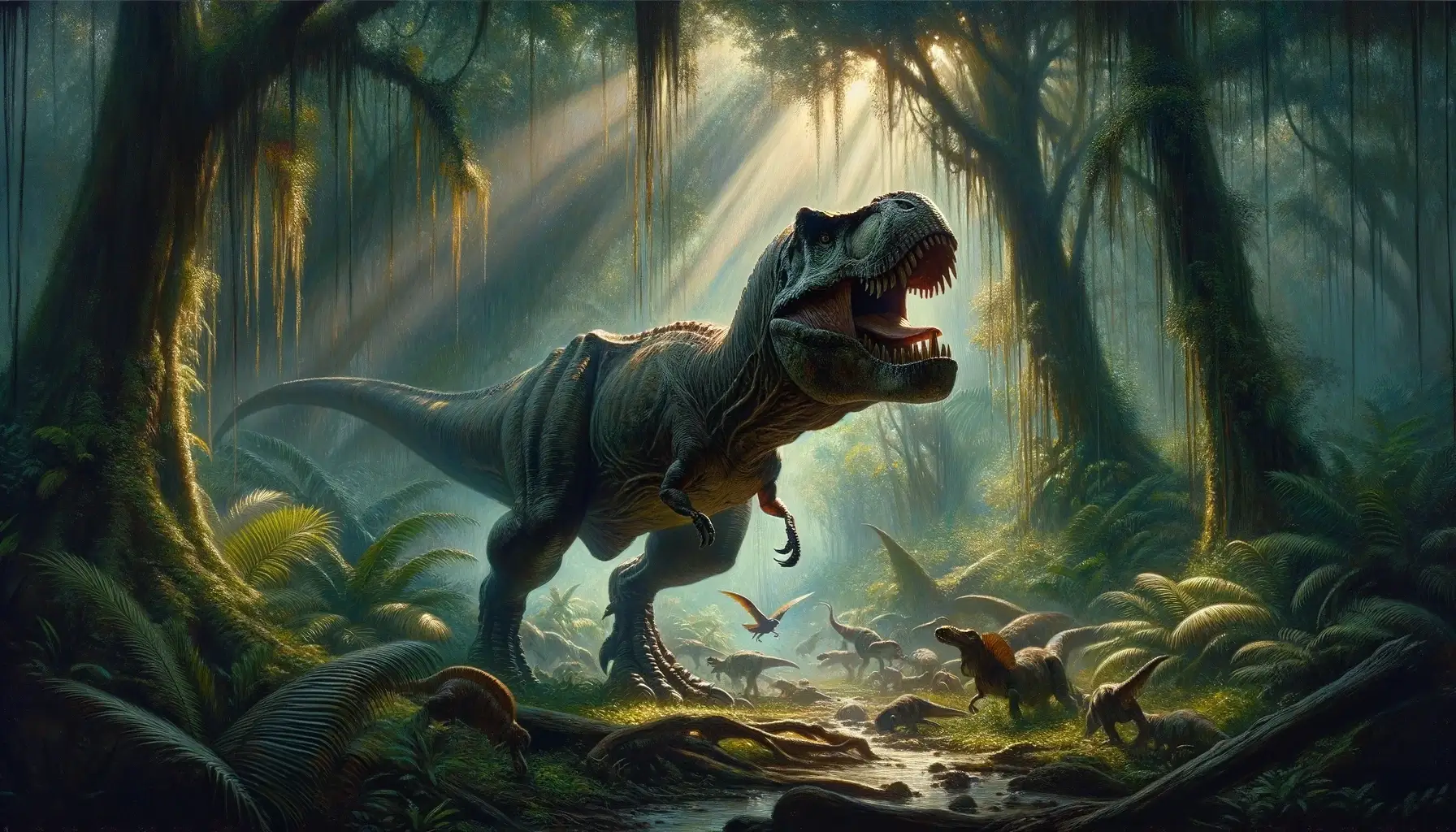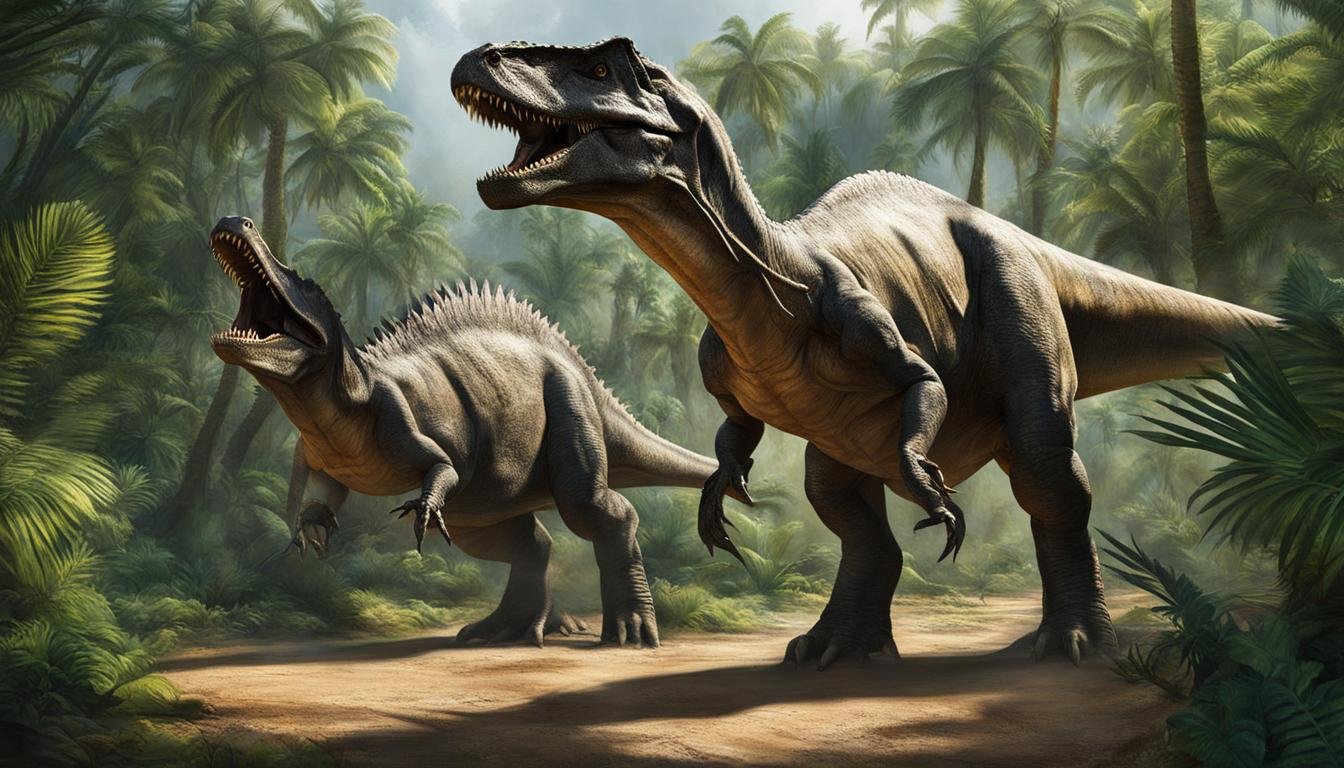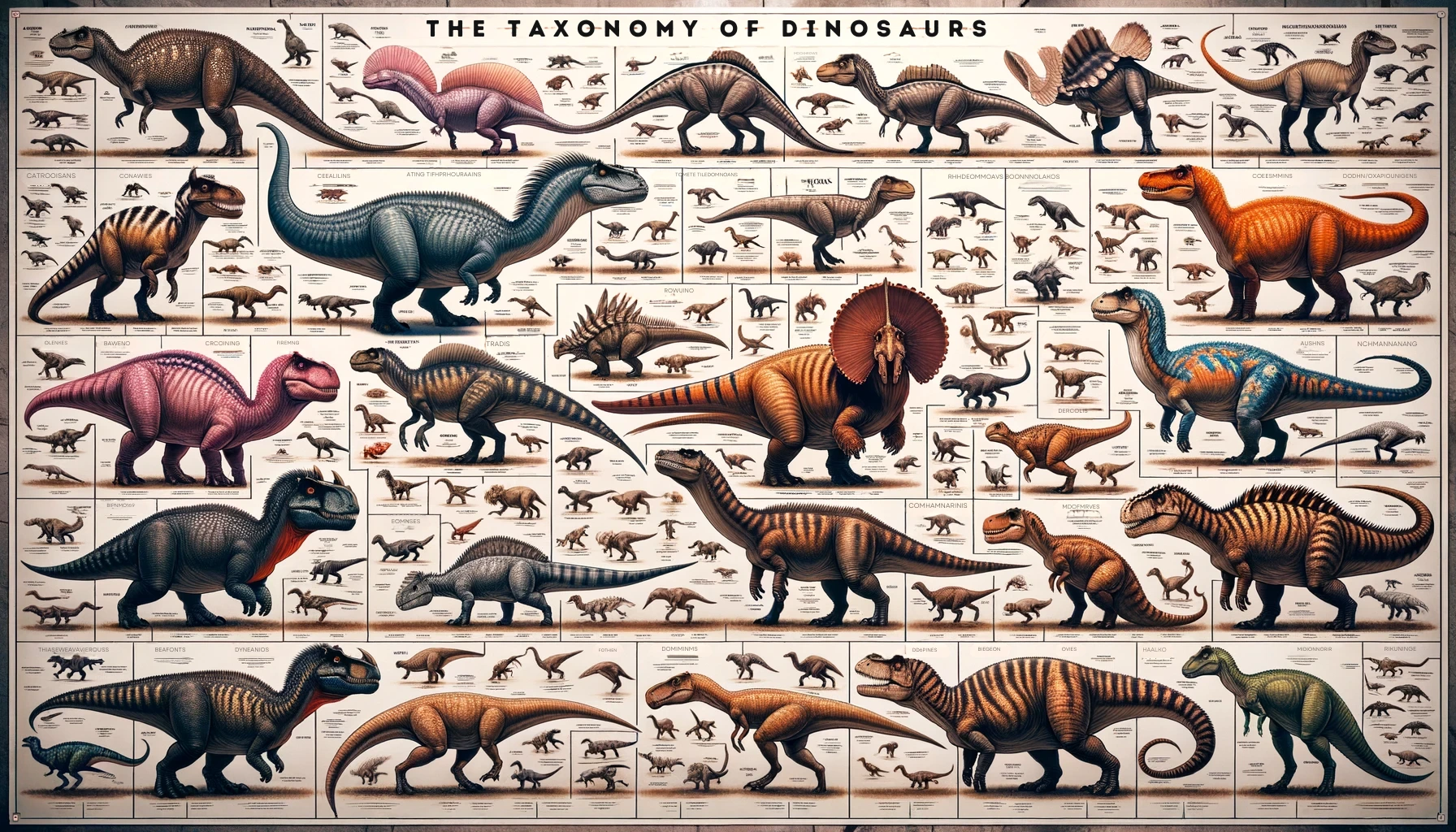The eerie cry of a distant predator echoes through the dense prehistoric forest. As the leaves tremble with dread, the king of the Mesozoic era steps into the open, its colossal silhouette a spell of death. This was the realm of the carnivorous dinosaur types, a time when giant predators roamed the earth in search of prey. Carnivorous dinosaur types are a group of theropods that lived during the Mesozoic era, a period spanning between 252 to 66 million years ago. Their existence provides crucial insight into the Earth’s evolutionary narrative, unveiling the dynamic ecosystem that thrived before humanity. This article aims to guide you through a journey across time, exploring the various types of carnivorous dinosaurs, their distinctive characteristics, diets, and notable examples.
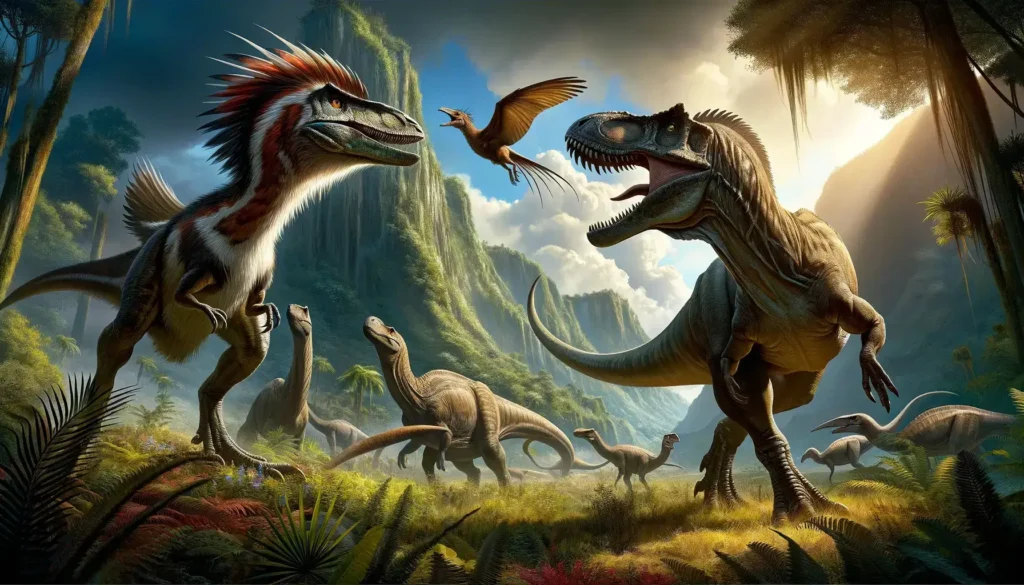
What are Carnivorous Dinosaur Types?
Carnivorous dinosaurs are a subset of theropods, distinguished by their meat-eating habits, sharp teeth designed for tearing flesh, formidable claws, and bipedal posture enabling swift movement. The cosmos of carnivorous dinosaur types is primarily divided into two significant factions: coelurosaurs and ceratosaurs.
- Coelurosaurs: This group is known for their lighter build and often feathered bodies. Some famous members include the Tyrannosaurus and Velociraptor.
- Ceratosaurs: They are recognized by their more robust bodies and horns or crests on their heads. Carnotaurus is a well-known member of this group.
Diving deeper into their anatomy reveals fascinating common characteristics like intracranial joints that allowed for more substantial bite forces, long hollow bones providing a balance between strength and weight, S-shaped necks for enhanced mobility, and air sacs within their bones similar to modern-day birds, hinting at a high metabolic rate.
The life of a carnivorous dinosaur was not just about ferocious roars and fearsome hunts; it was a complex interplay of survival strategies amidst competition and environmental vicissitudes. Their hunting strategies were as diverse as their species. While the larger predators relied on their size and strength, the smaller, agile ones banked on their speed and cunning. The competition was fierce, not just among different species but also within the same species over territorial claims and mating rights. Environmental changes, like shifting continents and fluctuating climates, constantly challenged their adaptability. The pressure to evolve and adapt was relentless, and their journey through the Mesozoic era is a testament to nature’s unyielding march towards diversity and complexity.
Their existence raises exhilarating questions. What types of carnivorous dinosaurs walked the Earth? What made each of them unique? What was their world like? As we delve deeper into the subsequent sections, we will unravel the world of these magnificent predators of the Mesozoic, each section a step closer to understanding the enigmatic realm they thrived in.
Types of Carnivorous Dinosaurs
As we traverse back in time, we unfold the tapestry of the Mesozoic era, revealing a plethora of carnivorous dinosaurs each with their unique adaptations, fulfilling the relentless call of nature in their pursuit of survival. They can be broadly categorized based on their size, shape, and unique adaptations. Here, we delve into the main types, taking a closer look at the awe-inspiring attributes that set them apart.
| Type | Description | Examples |
|---|---|---|
| Large Carnivorous | Biggest, most powerful predators of the Mesozoic. | Tyrannosaurus rex, Giganotosaurus, Carcharodontosaurus, Spinosaurus |
| Small Carnivorous | Fastest, most agile hunters of the Mesozoic. | Velociraptor, Deinonychus, Compsognathus, Microraptor |
| Spined Carnivorous | Distinctive, mysterious predators with spines or sails. | Spinosaurus, Acrocanthosaurus, Dilophosaurus, Ouranosaurus |
| Feathered Carnivorous | Advanced, diverse predators with feathers or proto-feathers. | Archaeopteryx, Oviraptor, Yutyrannus, Sinosauropteryx |
Large Carnivorous Dinosaur Types
These towering behemoths were the epitome of predatory evolution, boasting massive heads, powerful jaws capable of delivering bone-crushing bites, and long tails that aided in balance while chasing prey. Their sheer size made them the undisputed apex predators of their time.
- Tyrannosaurus rex: Stretching up to 12 meters (39 feet) in length and weighing around 8,500 kilograms (18,700 pounds), the T-rex was a fearsome predator with one of the strongest bite forces among all terrestrial animals.
- Giganotosaurus: A giant from the Cretaceous period, measuring up to 13 meters (42.6 feet) with a weight tipping at 13,200 kilograms (29,100 pounds), slightly larger and arguably more terrifying than the T-Rex.
- Carcharodontosaurus: Its name translates to “shark-toothed lizard”, and it lived up to it with teeth perfect for slicing through flesh. It measured up to 13 meters (42.6 feet) and weighed around 6,200 kilograms (13,668 pounds).
- Spinosaurus: The Spinosaurus was a behemoth, measuring up to 15 meters (49 feet) and weighing about 7,257 kilograms (16,000 pounds), with a distinctive sail on its back which could have been used for thermal regulation or attracting mates.
Small Carnivorous Dinosaurs Types
In contrast, the Mesozoic era also witnessed the rise of smaller, more agile carnivorous dinosaurs. Their slender bodies, long legs, and sharp claws made them lethal hunters despite their size.
- Velociraptor: A swift predator measuring 2 meters (6.6 feet) in length and weighing around 15 kilograms (33 pounds), known for its cunning and a sickle-shaped claw on each foot.
- Deinonychus: Slightly larger than the Velociraptor, with a length of 3.4 meters (11 feet) and a weight of 73 kilograms (160 pounds), it was a fearsome hunter of its time.
- Compsognathus: One of the smallest known dinosaurs, measuring only 1 meter (3.3 feet) in length and weighing a mere 3 kilograms (6.6 pounds).
- Microraptor: A four-winged dinosaur measuring around 0.77 meters (2.5 feet) with a weight of 1 kilogram (2.2 pounds), showcasing an early experiment of nature with flight.
Spined Carnivorous Dinosaurs Types
These were among the most distinctive and enigmatic predators of the Mesozoic era, adorned with large spines or sails on their backs.
- Acrocanthosaurus: Known for its high neural spines, it measured up to 11.5 meters (38 feet) and weighed around 6,350 kilograms (14,000 pounds).
- Dilophosaurus: With a pair of crests on its head, it measured around 6 meters (20 feet) and weighed about 500 kilograms (1,102 pounds).
- Ouranosaurus: Though not a carnivore, it’s worth mentioning due to its distinctive sail, measuring 7 meters (23 feet) in length and weighing around 4,000 kilograms (8,818 pounds).
Feathered Carnivorous Dinosaurs Types
The evolution of feathers among these dinosaurs showcases a significant leap towards the avian lineage. Their feathers or proto-feathers could have served various functions like insulation, display, or even flight.
- Archaeopteryx: Often dubbed as the “first bird”, measuring 0.5 meters (1.6 feet) and weighing around 0.8 kilograms (1.8 pounds), it showcased a blend of avian and reptilian features.
- Oviraptor: Despite its name meaning “egg thief”, recent findings suggest it might have been protecting its eggs. It measured 2 meters (6.6 feet) and weighed around 36 kilograms (79 pounds).
- Yutyrannus: A fascinating blend of fearsome and feathered, measuring 9 meters (29.5 feet) and weighing 1,414 kilograms (3,120 pounds), it was covered in simple feathers despite its large size.
- Sinosauropteryx: Known for its distinctive tail feathers and a coat of downy fluff, it measured 1.07 meters (3.5 feet) and weighed around 0.5 kilograms (1.1 pounds).
Each of these carnivorous dinosaurs depicts a unique narrative, a testament to the incredible diversity and evolutionary experimentation during the Mesozoic era. As we venture further, we will explore some notable examples, shedding light on their lifestyles, behaviors, and the indelible mark they left on Earth’s evolutionary saga.
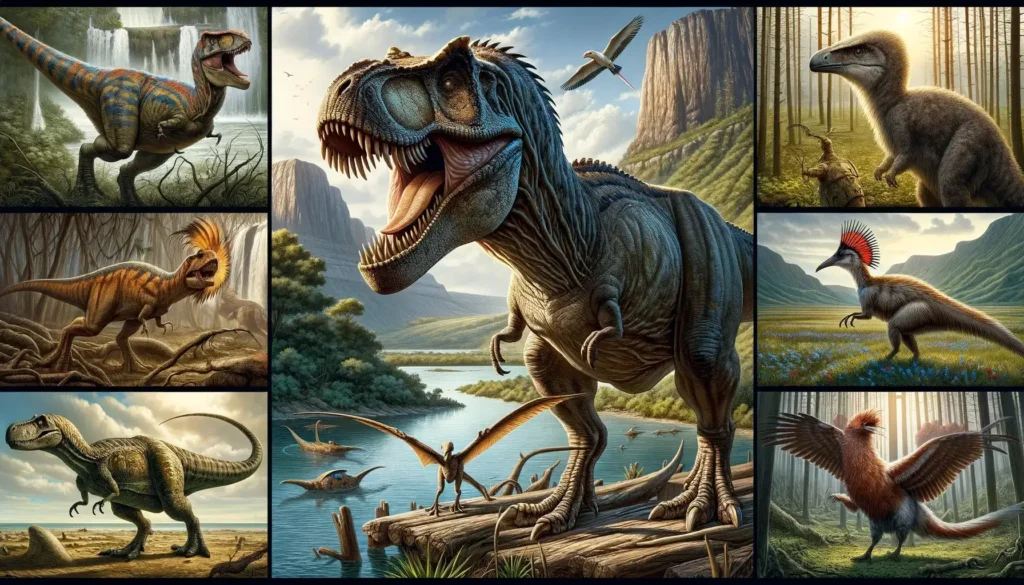
Examples of Carnivorous Dinosaur Types
The Mesozoic era was a tableau of relentless predation and survival, where carnivorous dinosaurs ruled the roost with their awe-inspiring adaptations. Let’s dive deeper into the lives of some of the most iconic carnivorous dinosaurs, each bearing a unique signature in the annals of prehistory.
Tyrannosaurus rex
The king of the dinosaurs stood as a colossal emblem of predatory might in the late Cretaceous period. Native to North America, the Tyrannosaurus rex or T-rex was a terror on two legs, flaunting a massive head armed with serrated teeth capable of crushing bones, delivering a bite force of a staggering 8,000 pounds of pressure. Despite their fearsome jaws, T-rexes had comically small arms, each bearing two fingers.
- Length: Up to 12 meters (39 feet)
- Weight: Approx 8,500 kilograms (18,700 pounds)
- Diet: Carnivorous, primarily large herbivores
- Period: Late Cretaceous, about 68 to 66 million years ago
- Region: North America
Velociraptor
Thanks to its depiction in Jurassic Park, the Velociraptor enjoys a celebrity status among dinosaurs. This swift thief roamed Asia during the late Cretaceous period, showcasing a blend of agility and cunning in its hunt. With a long tail for balance and a large sickle-shaped claw on each foot, it was a small but potent predator. The feathers on its arms and tail hint at its close relationship with birds.
- Length: 2 meters (6.6 feet)
- Weight: 15 kilograms (33 pounds)
- Diet: Carnivorous, smaller prey
- Period: Late Cretaceous, about 75 to 71 million years ago
- Region: Asia
Spinosaurus
The Spinosaurus holds the title of the largest carnivorous dinosaur, dwarfing even the T-rex. Its distinctive sail and crocodile-like snout set it apart. Residing in what is now North Africa during the late Cretaceous period, its conical teeth and elongated snout were perfect for catching fish, suggesting a semi-aquatic lifestyle. The sail on its back, a structure of elongated spines covered by skin, could have been used for temperature regulation or attracting mates.
- Length: Up to 15 meters (49 feet)
- Weight: Approx 7,257 kilograms (16,000 pounds)
- Diet: Piscivorous, with a potential for hunting smaller prey
- Period: Late Cretaceous, about 112 to 93.5 million years ago
- Region: Africa
Archaeopteryx
The Archaeopteryx bridges the gap between dinosaurs and birds. Living in Europe during the late Jurassic period, it bore a mix of avian and reptilian features – teeth, claws, feathers, and wings. Despite its wings, its flight was likely limited, resembling more of a gliding or flapping while climbing. Whether a scavenger or a predator of small animals, it remains a critical piece in understanding the evolutionary lineage leading to modern birds.
- Length: 0.5 meters (1.6 feet)
- Weight: 0.8 kilograms (1.8 pounds)
- Diet: Carnivorous, possibly insects and small animals
- Period: Late Jurassic, about 150.8 to 148.5 million years ago
- Region: Europe
These dinosaurs, each with their unique traits, showcase the remarkable diversity and evolutionary ingenuity of carnivorous dinosaurs during the Mesozoic era. Through their bone fragments and footprints, they continue to fascinate and unravel the mysteries of a bygone world dominated by these magnificent predators.

Evolution and Diversity of Carnivorous Dinosaur Types
The tale of the carnivorous dinosaurs begins in the Triassic period, around 230 million years ago, from a common ancestor. Their evolutionary journey is a riveting saga of diversification and adaptation, painting a vivid picture of the forces of natural selection at play.
Evolutionary Roots
The carnivorous dinosaurs, belonging to the larger group of theropods, trace their lineage back to the early dinosaurs of the Triassic period. This era saw the birth of various archaic forms which were the stepping stones to the astonishing diversity of carnivorous dinosaurs in the subsequent Jurassic and Cretaceous periods. The initial theropods were small, bipedal, and clothed with a simple coat of fur-like feathers.
Diversification Over Time
As time marched from the Triassic into the Jurassic and then the Cretaceous period, these carnivorous behemoths diversified into a myriad of forms, each adapted to the ecological niches and environments they inhabited. From the nimble, bird-like dromaeosaurs to the towering tyrannosaurs, the Mesozoic era was a testament to the evolutionary flexibility of these apex predators.
| Dinosaur Group | Characteristics | Time Period |
|---|---|---|
| Coelurosaurs | Small to medium-sized, often feathered | Jurassic to Cretaceous |
| Ceratosaurs | Primitive, robust build | Late Triassic to Late Jurassic |
| Spinosaurids | Semi-aquatic adaptations | Early to Late Cretaceous |
| Tyrannosaurids | Large-bodied, massive skulls | Late Cretaceous |
Phylogenetic Relationships
A glimpse into the phylogenetic tree or cladogram of carnivorous dinosaurs reveals a branching pattern of evolution. The basal split among theropods leads to various lineages, each boasting unique adaptations. From the primitive ceratosaurs to the more derived coelurosaurs, the tree of evolution branches out, weaving a narrative of adaptive radiation.
Key Evolutionary Transitions
The evolutionary road of carnivorous dinosaurs saw many remarkable transitions:
- Feather Evolution: The discovery of feathers in non-avian dinosaurs like Yutyrannus and Velociraptor shed light on the evolution of feathers and flight, hinting at a close relationship between birds and dinosaurs.
- Flight: The evolutionary leap from ground-dwelling theropods to flying or gliding forms like Archaeopteryx and Microraptor showcases one of nature’s most fascinating transitions.
- Gigantism: The evolution of giant forms like Tyrannosaurus and Spinosaurus represented a trend towards gigantism, enabling these predators to dominate the top tiers of the food chain.
- Dietary Adaptations: Varying skull shapes and tooth structures among different theropods hint at dietary adaptations, from the bone-crushing bites of tyrannosaurs to the piscivorous preferences of spinosaurids.
The evolutionary tapestry of carnivorous dinosaurs is an unfolding story that continues to captivate scientists and enthusiasts alike. Each fossil discovery adds a new chapter to this remarkable saga, enriching our understanding of the life and times of these magnificent creatures that once roamed our planet. Through the lens of paleontology, the evolutionary history of carnivorous dinosaurs offers a vivid glimpse into the dynamism and resilience of life on Earth.
Behavior and Ecology of Carnivorous Dinosaur Types
The behavior and ecology of carnivorous dinosaurs reveal a fascinating blend of brute force, social intricacies, and adaptations that were instrumental in their survival in the fiercely competitive Mesozoic world. Let’s delve into the various aspects of their behavior and interactions with the environment and other organisms.
Hunting and Feeding
Carnivorous dinosaur types were at the pinnacle of the food chain, their hunting and feeding behaviors showcasing a range of strategies honed for maximum efficiency.
- Finding Prey: With keen senses, they could locate prey from afar. For instance, the large olfactory bulbs of Tyrannosaurus rex suggest a highly developed sense of smell.
- Catching Prey: They employed a variety of hunting strategies. While the swift Velociraptor relied on its speed and agility, the colossal T. rex used its massive jaws to deliver bone-shattering bites.
- Consuming Prey: Their dietary preferences varied, from large herbivores hunted by T. rex to the fish favored by Spinosaurus. Their teeth were specialized; the serrated teeth of T. rex were perfect for crushing bones, while the conical teeth of Spinosaurus were suited for catching slippery fish.
- Competitors and Scavengers: The realm of carnivorous dinosaurs was one of fierce competition. They defended their kills from scavengers and sometimes even engaged in combat with other predators over food resources.
Communication and Socialization
The social dynamics among these prehistoric predators were complex, with evidence hinting at both solitary and social behaviors.
- Vocalization: The possibly vocal communications among carnivorous dinosaurs, like calls or roars, played a role in coordinating hunts or warning others of threats.
- Social Groups: Some species like Velociraptor might have hunted in packs, indicating a level of social organization.
- Hierarchies: Dominance hierarchies could have existed, with stronger individuals asserting control over resources.
Reproduction and Parenting
Reproduction was a central aspect of the lifecycle of carnivorous dinosaurs, with fossil evidence shedding light on their nesting behaviors and parental care.
- Mating: Mating rituals might have involved displays of strength or ornamental features.
- Nesting and Eggs: They laid eggs, often in carefully constructed nests. Fossils of oviraptorids, like Oviraptor, have been found in brooding positions over nests, hinting at parental care.
- Parental Care: While the extent of parental care varied, some species likely guarded their nests and possibly brought food to their young.
Growth and Development
The journey from hatchling to adult was fraught with dangers, yet the rapid growth rates and developmental changes equipped carnivorous dinosaurs for survival.
- Growth Rates: Many carnivorous dinosaurs experienced rapid growth spurts, enabling them to attain a sizeable stature early in life to fend off predators and hunt efficiently.
- Longevity: While the lifespan varied among species, some like T. rex could live into their late 20s or early 30s.
The behavioral and ecological facets of carnivorous dinosaurs offer a captivating look into their daily lives, survival strategies, and interactions with the Mesozoic landscape. Each bone uncovered and fossil trackway studied propels us further into the heart of the mysteries surrounding these magnificent creatures of the ancient world. Through the annals of paleontological research, we continue to unravel the complex tapestry of behaviors and ecological interactions that underpinned the existence of carnivorous dinosaurs in their bygone realms.
Conclusion
The captivating realm of carnivorous dinosaur types unveils a tapestry of evolutionary artistry, adaptational genius, and ecological intricacies. These formidable predators of the Mesozoic era, ranging from the fearsome Tyrannosaurus rex to the enigmatic Spinosaurus, have not only imprinted their colossal footprints on the ancient earth but also left an indelible mark on our understanding of life’s prehistoric narrative. Their diverse forms, adaptive innovations, and complex behaviors exhibit the relentless force of evolution, driving a ceaseless engine of ecological interaction amidst the ever-changing theatre of Earth’s ancient ecosystems. As we peel back the layers of geological time, the bones, teeth, and traces of these ancient predators whisper the tales of a bygone world, a world where giants roamed and the laws of nature painted a picture of survival, competition, and adaptability.
Frequently Asked Questions (FAQ)
1. When did carnivorous dinosaur types live?
Carnivorous dinosaurs thrived during the Mesozoic era, a period extending from about 252 to 66 million years ago, encompassing the Triassic, Jurassic, and Cretaceous periods.
2. What were the largest carnivorous dinosaur types?
The Tyrannosaurus rex and Spinosaurus are among the largest carnivorous dinosaurs, with the latter possibly reaching lengths of up to 18 meters (59 feet).
3. Did any carnivorous dinosaur types have feathers?
Yes, many smaller carnivorous dinosaurs like Velociraptor and Yutyrannus had feathers or proto-feathers. The discovery of feathers on these dinosaurs provides a fascinating link between dinosaurs and birds.
4. How did carnivorous dinosaur types hunt?
Their hunting strategies varied with their physical attributes. For instance, while large carnivorous dinosaurs relied on their sheer size and strength, smaller ones like Velociraptor utilized their agility and speed to catch prey.
5. What did carnivorous dinosaur types eat?
Their diet primarily consisted of other dinosaurs or marine animals, depending on their habitat. For instance, while Tyrannosaurus rex preyed on large herbivorous dinosaurs, Spinosaurus is believed to have had a diet rich in fish.
6. How do we know about the behavior of carnivorous dinosaur types?
Much of what we know comes from the examination of fossil remains and footprints, which offer clues about their hunting behaviors, social interactions, and parenting habits. Additionally, the study of modern-day animals and birds, the closest living relatives of dinosaurs, also provides insights into their possible behaviors.
7. How fast could carnivorous dinosaur types run?
The speed varied among species. For instance, it’s estimated that Tyrannosaurus rex could run at speeds of up to 25 km/h (15.5 mph), while smaller and more agile carnivores like Velociraptor could potentially achieve higher speeds.

